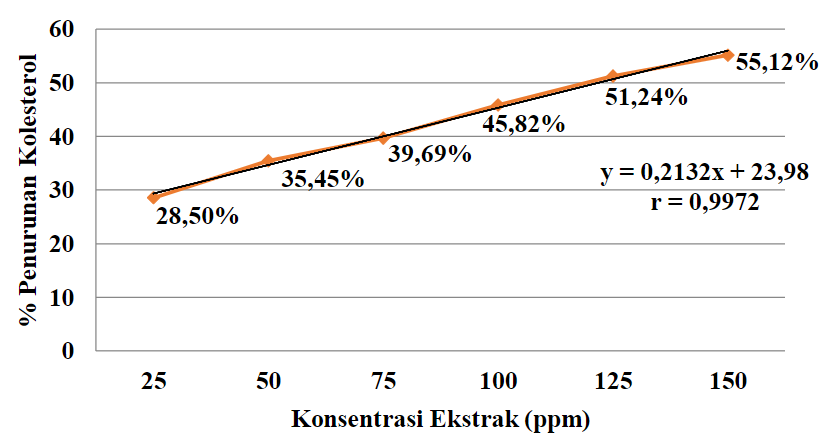Main Article Content
Abstract
The liver has a very important role in the human body. However, these organ tissues are also very susceptible to be tissue damage. Fatty liver disease (steatosis) is a disease caused by high cholesterol. Physically, cholesterol is a yellowish subtance, lumps like wax, and is an arrangement of steroid groups. Non-alcoholic steatohepatitis (NASH) occurs due to excess cholesterol levels in the liver. Liver function can be affected as a result of liver damage. So, a hepatoprotector is needed. The flavonoid content of cucumber skin has potential as an anticholesterol. The purpose of this research is to analyze the ability of the ethanol extract of cucumber peel (Cucumis sativus L.) as a cholesterol lowering agents as indicated by the EC50 value. Maceration extraction method used in this study using 96% ethanol as solvent. Qualitative analysis of ethanolic extract of cucumber peel is known to have flavonoids, steroids, alkaloids as indicated by the appearance of color changes, and saponins which are indicated by the appearance of foam. Lieberman-burchad reagent was used for quantitative analysis of anticholesterol using a UV-Visible spectrophotometer. The analysis was carried out at a maximum wavelength of 665,0 nm with an incubation time of 15 minutes. The concentration variations of the extract used were between 25-150 with a range of 25 ppm. The results showed that the ethanolic extract of cucumber peel could potentially be an anticholesterol with the percentage reduction of 28.50%; 35.45%; 39.59%; 45.82%; 51.24%; and 55.12% at 5 variations of concentration. The EC50 value was achieved at a concentration of 122.04 ppm.
Keywords
Article Details

This work is licensed under a Creative Commons Attribution-NonCommercial 4.0 International License.
References
- Agustin, V., & Gunawan, S. (2019). Uji Fitokimia Dan Aktivitas Antioksidan Ekstrak Mentimun (Cucumis Sativus). Tarumanagara Medical Journal, 2(1), 195–200.
- Amin, M. S. (2015). Studi In Vitro; Efek Antikolesterol Dari Ekstrak Metanol Buah Parijoto (Medinilla Speciosa Blume) Terhadap Kolesterol Total [B.S. Thesis]. Uin Syarif Hidayatullah Jakarta: Fakultas Kedokteran Dan Ilmu Kesehatan, 2015.
- Anggraini, D. I., & Kusuma, E. W. (2019). Uji Potensi Fraksi Etil Asetat Kulit Buah Apel Hijau (Pyrus Malus L.) Terhadap Penurunan Kadar Kolesterol Secara In Vitro. Cendekia Eksakta, 4(1).
- Anggraini, D. I., & Mm, A. (2017). Uji Aktivitas Antikolesterol Ekstrak Etanol Daun Binahong (Anredera Cordifolia (Ten) Steenis) Secara In Vitro. Jurnal Ilmiah Kesehatan, 9(1), 1–6.
- Anggraini, D. I., & Nabillah, L. F. (2018). Activity Test of Suji Leaf Extract (Dracaena Angustifolia Roxb.) On In Vitro Cholesterol Lowering. Jurnal Kimia Sains Dan Aplikasi, 21(2), 54–58.
- Dewi, N. P., Kristianto, A., & Tandi, J. (2018). Uji Efek Ekstrak Etanol Daun Ceremai Terhadap Penurunan Kadar Kolesterol Total Tikus Putih Jantan. Farmakologika: Jurnal Farmasi, 15(2), 89–97.
- Hardjana, T., Pertiwi, K. R., & Rahayu, T. (2016). Potensi Buah Salak (Salacca Edulis, R.) Sebagai Suplemen Hipolipidemik Ditinjau Dari Gambaran Histopatologi Jantung Dan Hepar Mencit Yang Diberi Diet Rendah Lemak. Jurnal Sains Dasar, 5(2), 94–106.
- Harmita, H. (2012). Petunjuk Pelaksanaan Validasi Metode Dan Cara Perhitungannya. Pharmaceutical Sciences and Research (Psr), 1(3), 117–135.
- John, S., S, P., Monica, S. J., C, S., & P, A. (2018). In Vitro Antioxidant and Antimicrobial Properties of Cucumis Sativus L. Peel Extracts. International Research Journal of Pharmacy, 9(1), 56–60. Https://Doi.Org/10.7897/2230-8407.0918
- Luginda, R. A., Sari, B. L., & Indriani, L. (2018). Pengaruh Variasi Konsentrasi Pelarut Etanol Terhadap Kadar Flavonoid Total Daun Beluntas (Pluchea Indica (L.) Less) Dengan Metode Microwave–Assisted Extraction (Mae). Jurnal Online Mahasiswa (Jom) Bidang Farmasi, 1(1).
- Luhurningtyas, F. P., Hasani, N., Aprilliana, M., Saputra, D., & Prayasanti, D. (2019). Pengaruh Kombinasi Ekstrak Daun Ashitaba (Angelica Keiskei Ito.) Dan Daun Sukun (Artocarpus Communis) Terhadap Kadar Glukosa Dan Kolesterol Secara In Vitro Menggunakan Metode Fotometri. Fitofarmaka: Jurnal Ilmiah Farmasi, 9(1), 47–55. Https://Doi.Org/10.33751/Jf.V9i1.1260
- Lutfita, R. D. (2012). Pengaruh Perbedaan Metode Ekstraksi Terhadap Kandungan Flavanoid Total Dan Aktivitas Antioksidan Brokoli (Brassica Oleracea L. Cv. Group Broccoli). Skripsi. Bandung: Universitas Islam Bandung, 27–28.
- Na’im, F. (2016). Aktivitas Ekstrak Daun Jati Belanda Terhadap Kadar Kolesterol Hdl Dan Ldl Pada Tikus Hiperkolesterolemia [Phd Thesis]. Universitas Negeri Semarang.
- Nofanni, I. M., & Ruqoyah, D. (2016). Uji Aktivitas Hepatoprotektor Dan Antioksidan Fraksi Etil Asetat Daun Kenikir (Cosmos Caudatus K) Pada Tikus Jantan Galur Wistar Yang Diinduksi Alkohol. Jurnal Kesehatan Kusuma Husada.
- Rusmini, H., Marlina, D., & Lestari, P. (2019). Pengaruh Flavonoid Dalam Ekstrak Mentimun (Cucumis Sativus L.) Terhadap Kadar Kolesterol Total Darah Mencit (Mus Musculus L.) Yang Mengonsumsi Makanan Cepat Saji. Jurnal Ilmu Kedokteran Dan Kesehatan, 6(3), 166-175.
- Sari, D. T. (2018). Ekstraksi Senyawa Bioaktif pada Timun Aceh (Cucumis sativus L.) dengan Variasi Jenis Pelarut dan Waktu Ekstraksi. Skripsi, Jurusan Teknologi Hasil Pertanian, Universitas Syiah Kuala, Banda Aceh.
- Sumardjo, D. (2009). Pengantar Kimia Buku Panduan Kuliah Mahasiswa Kedokteran. EGC.
- Venugopal, S. K., Devaraj, S., Yuhanna, I., Shaul, P., & Jialal, I. (2002). Demonstration That C-Reactive Protein Decreases Enos Expression and Bioactivity in Human Aortic Endothelial Cells. Circulation, 106(12), 1439–1441.
- Vinarova, L., Vinarov, Z., Atanasov, V., Pantcheva, I., Tcholakova, S., Denkov, N., & Stoyanov, S. (2015). Lowering Of Cholesterol Bioaccessibility and Serum Concentrations By Saponins: In Vitro And In Vivo Studies. Food & Function, 6(2), 501–512.
- Wardani, Vanissa, R., Fatimah, S., Nadia., Intan Martha, C. (2019). Aktivitas Ekstrak Etanol Kulit Melinjo (Gnetum Gnemon L.) Sebagai Antihiperkolesterol. Media Farmasi Indonesia, 14(1), 1466-1470.
